Author Archives: admin
-
Add Your Website to Google Search Console in 3 Easy Steps!
Leave a CommentWe have noticed that most business owners invest their time and budget in designing and developing their brand’s website, and understandably so. But launching a successful website has so much more going on. We are here to briefly introduce you to the behind-the-scenes of launching our clients’ website. Any marketing agency worth their salt will ensure that Google Analytics will capture any activity or action the moment your website is public.
The reason behind linking your website to Google Analytics is to be able to optimise it later and track website traffic and other important metrics to ensure it is algorithm-friendly.
Firstly, we create a Google Analytics account and link the website to that Google Analytics account.
Then, create and link Google Search Console to gain SERPs-related performance reports. As well as, insights to help rank the website higher on search engines (SERPs), track its performance and keep improving.
Optimally, increasing the organic click-through rate, therefore, increasing sales.
Google Search Console is a free tool provided by Google to measure and deliver comprehensive website analytics.
This article will go through what is Google Search Console and how to connect your website to Google Search Console easily.
What is Google Search Console?
Google Search Console (GSC) is a free dashboard that enables any website owner to improve their site’s performance in Google Search results. Previously known as Google Webmaster Tools, it gives you everything you need to boost your search rankings.
Google Search Console provides insights when it comes to your website’s performance on different surfaces:
- Search
- Discover
- News
These are some of the data that GSC provides:
- Organic Impressions: A user saw a link to your page or site in a Google service (Search, News, or Discover).
- Organic Clicks: A user clicked a link to your page or site in a Google service (Search, News, or Discover).
- Organic Click-through rate: Clicks divided by impressions
You can check out this link for more metrics that Google Search Console measures.
It is best to link your Google Search Console to your Google Analytics account to have a comprehensive reporting system in one place. It will help you understand your search traffic and make optimisations that help increase your organic ranking and click-through rate.
Any business owner must understand what his team is working with and what needs to be done, especially for small businesses with tight resources and budgets. It is essential to armour yourself with these details. Even if you invest in working with a marketing agency, and they already do all those details, it is best to understand the know-how of such technical information; you’ll reap the benefits later.
If you have missed it, read our list of advantages when you invest in a good marketing agency. For when you are on the fence of slimming your marketing budget. Why Hire A Marketing Agency.
Now, let’s get to connecting your new website to Google Search Console.
Add Your WordPress Site to Google Search Console in 3 Easy Steps.
- Click the “Start Now” button on Google Search Console website
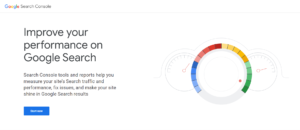
- Enter your domain or website URL. (consider which kind of verification you will use.) — Check out this link for more details about verifying a website’s ownership. —
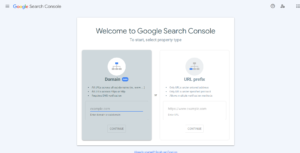
- Verify ownership of the website in multiple ways:
- By downloading the HTML file and then uploading it to your website.
- Via DNS record by copying the TXT record into the DNS configuration for your website provided by Google Search Console.
Click “verify”, and you are done!
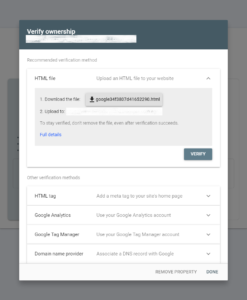

There are other verification methods that you can use (As the above image shows):
- HTML Tag
- Use your Google Analytics account
- Use your Google Tag Manager account
- Associate a DNS record with Google
There you go. Once the verification step is successful, your google search console account will be set up!
You can click the ‘Go to Property’ link on your Google Search Console dashboard.
Knowing the benefits and how-tos of tools like Google Search Console is one example of the many things marketers, web developers, and business owners should know how it works to keep adding weapons to their knowledge arsenal.
These free tools, like GA4 and Google Search Console, are designed to support website owners. They help business owners optimise and keep updating their websites with valuable content and engaging material to keep visitors hooked. Business owners should utilise them effectively and enhance their digital presence accordingly to reach and attain new customers and optimise leads and sales.
-
Your guide to Organic Click-Through Rate (CTR) and how to improve it!
Leave a CommentDo you find yourself fighting against the algorithm rather than flowing with it and reaping the benefits?
In this article, we will simplify the metric Click-Through Rate and show you six proven ways to improve organic Click-Through Rate (CTR) and rank higher on google and other search engine result pages (SERPs)!
What is Click-Through Rate (ctr)?
Click-Through Rate (CTR) is the percentage of people visiting a web page from an advertisement or organic search result.
To calculate the CTR, use the following formula:
CTR = (number of clicks / number of impressions) х 100
For example, if we have a web page with 300 searchers’ impressions but only 30 people decided to click the link. Let’s calculate the CTR according to the above Click-Through Rate formula:
CTR = (30 / 300) x 100 = 10%
You can find the average Click-Through Rate and more helpful analytics through Google Search Console, a free tool offered by Google to help website owners see how their website is doing in search results.
If you haven’t done so, follow our guide to learn how to add your website to Google Search Console in 3 easy steps. [add article link].
What is A Good Organic Click-Through Rate?
There are two approaches to define what is the average CTR.
- Base the good CTR on your own CTR. If the highest Click-Through Rate is 7%, then you should aim to increase it to 8%, then 9% and so forth.
- Determine the average CTR in your industry and compare it to your website’s performance.
It is an ongoing optimisation process, and an essential part of it is frequently publishing relevant content to enrich your website’s SEO and internal linking. It is also crucial to understand the importance of content relevance and SEO.
Much published research indicates that ranking higher on google and other SERPs directly correlates to Click-Through Rate. And click-worthy websites can be achieved by spot-on SEO. Recent research conducted by Ignite Visibility shows that Click-Through Rate is directly related to position on Google. Check the graph below.
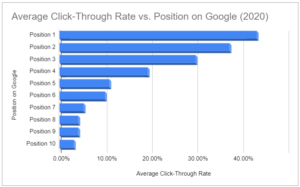
Why Is It Vital to Care About Organic Click-Through Rate?
Increasing your organic CTR has many SEO and business benefits. Here are the top 3:
- More organic traffic: An increase in organic CTR means more people are clicking on your search listing, resulting in more organic traffic to your site. This means a better ROI for your SEO campaigns.
- Better SEO rankings: High CTRs signal to search engines that your content is valuable to users. As a result, they rank your content better.
- Increased revenue: An increase in organic CTR can ultimately lead to increased revenue for your business. This is because of the increase in traffic and leads.
While many businesses focus on boosting their SEO rankings, this alone is only part of the equation for having an impactful online presence. After all, ranking high is useless if people don’t click on your search listings.
Are you having trouble increasing your Click-Through Rate? Are you creating ads that don’t get clicked? Are you creating content that doesn’t get found?
You deserve the best! Find out how to increase your Click-Through Rate by getting a free proposal today! Contact us.
6 Organic Tactics to Enhance Your Click-Through Rate!
- Use long-tail Keywords
- Enrich content & relevant Keywords
- Rich snippets
- Add photos to the text
- Create more listicles
- Analyze current CTR & take action
Extra Bonus Check List to organically increase your Click-Through Rate!
- Do a Speed Test
- Is your website Mobile-friendly?
- Make sure to build a robust internal linking
- Do you use power words in your titles?
In conclusion, regularly optimising your website’s SEO and metadata and publishing rich content will improve your organic and paid advertising efforts.
The sweet spot is to write for your audience and edit for the algorithm by choosing your keywords, creating rich snippets and adding relevant photos for better search results. Get in the habit of extracting valuable insights from Google free tools like Google Search Console and Google Universal Analytics (GA4).
-
7 Marketing Myths: Debunked!
Leave a CommentMarketing is an ever-evolving industry, with new trends popping up every day to help businesses and brands connect with their customers. It’s easy to fall into the trap of believing everything you hear or read about marketing, but some of the things that get repeated most often are myths that no longer hold true in our social media and mobile world. Here’s a list of 7 marketing myths debunked, along with why they’re no longer true and what you should do instead.
- I’m too small to digitally market my business.
One of the most popular misconceptions about digital marketing is that it’s not worth the investment for a small company because they don’t have enough capital.
This couldn’t be further from the truth! Large companies do invest heavily in online marketing, but that doesn’t mean there isn’t room for smaller businesses to succeed too. Research proves that no matter what size company you are – whether you’re running a single-person shop or an enormous corporation – you can make use of digital marketing strategies and experience success.
Best of all? It won’t cost much to get started with these sorts of methods!
- Great products and services sell themselves
Having quality products or services is important, but what good is that if nobody knows about it? You could have a competing company and they could take your customers while you stand idly by.
Every brand needs to communicate and relate to its target audience so they can convert into customers – then once the customer has bought your product, they’ll validate your marketing claims.
- You must post several times a day to be successful on social media.
One of the more pervasive myths about digital marketing is that quantity beats quality.
This may have worked in the past, but it’s no longer the case. The idea is that if your competitors are posting 10 times per day and you post 15 times per day, then you will get more traffic than them. But this isn’t true anymore — Google has gotten smarter over time with its algorithms and it understands when companies are trying to manipulate their search results through keyword stuffing or spammy link building strategies.
For content marketing, the quality of your content is far more important than the quantity. Just one piece of exceptionally high-quality content can generate more traffic than dozens or hundreds of lower-quality pieces. Answering questions that your customers might have will bring you more organic traffic and more sales. You might even end up on the first page of search engine results, which is your goal.
- Advertising and Marketing are the same things
Advertising is a company paying for space to promote a product or a service. The goal of advertising is reaching as many people as possible who are willing to pay for what a company sells.
Marketing involves a much broader picture of how customers connect to a brand. A marketing strategy can involve running several types of advertisements, but marketing looks beyond the success of an ad campaign.
Businesses leverage advertising to promote their products and services for sale as well as establish corporate culture and branding. When employed properly and strategically, advertising can drive customer acquisition and boost sales.
- Marketing results are instant
All too often, those new to the marketing sector find themselves disappointed when their efforts do not work out immediately.
If you are not seeing a payoff to your marketing right away, surely you must be doing something wrong, right? Wrong.
If you use an online approach of marketing instead of more traditional ways – then yes, it’s true that you’ll likely see results faster than if you relied on them exclusively. But even this type of branding will still take time before paying off. It may take many clicks until one individual decides to contact you or make a purchase—and that’s just fine!
The majority of the most effective organic branding approaches are known for taking months before sizable results can be seen (even though they’re quicker than others). For example, paid advertising methods like sales funnels take some time too before getting qualified leads.
You’re going up against established opponents and big companies when using any type of branding campaign – so adjust your expectations about how long things will take accordingly.
- Creating a website is enough for your marketing.
Business owners often believe that investing in social media or a website is enough. But this isn’t true since both serve a different but interconnected goal – so neither alone is enough.
A website is one contact point, out of many others that you need to be successful in business. If people don’t see your site, how will they know about it? And if they don’t find it, how will they reach it? So it’s important to have one place where your target audience can access all information about the products/services you offer and then connect with you or buy online with ease – which typically fulfils the aim of having a website at all.
Meanwhile, utilising social media marketing to create a community of engaged fanbase through effective social media strategies, provides another way for potential buyers to come across your brand- converting them into customers.
- WordPress and Shopify are bad
Not. At. All. Actually, we love them!
There is a reason WordPress is the most used website building system in the world: It’s really good because hundreds of thousands of developers have invested hundreds of thousands of hours into these website building systems.
It’s an honourable ambition to do everything from scratch but it is:
- Likely going to fail or lack quality
- Going to take lots of precious time and money
- Going to be less flexible for your future plans.
You are not going to find a developer who can set you up with that quality, functionality, and flexibility within a few months. You’ll also spend all your budget and more on tech and code and likely notice that it doesn’t necessarily look pretty. Because the coder is no designer and you’ll have to spend even more on that.
Also: What if you want to add new functionality like a blog or an e-learning platform later on?
You’ll have to get that coder back to do it because you can do nothing on your own in that code maze.
It is much better to start with a reliable and standard website utilising the already established website building systems and hire developers to customise it and make it yours!
Conclusion
Not everyone is lucky enough to afford the expensive marketing campaigns of large brands. However, that does not mean that marketing strategies are useless! There are many ways to market your company without relying on a hefty bank account. Avoiding these traps and following some simple steps will help you grow your business and make it stand out among
If you’re still wondering “Is that everything? Did I get it all?”Let’s talk!
At Feur Media House, we’ve worked alongside various industries from support services to skin care. Our services range from social media strategy and content creation, paid advertisements to complete website overhauls, Feur’s experienced marketing and development teams have the skills to help your business. We want to learn about your business, empower your marketing team and be your creative partner. contact us at info@feur.com.au
-
Guerrilla Marketing guide
Leave a CommentA Comprehensive Guerrilla Marketing Guide for Small Businesses
Since Covid-19, companies big and small are facing hard decisions regarding budget. The economic turbulence is an added factor for cost-cutting, specially, in the marketing and advertising budgets. Businesses are trying to stay afloat hens, the reduced marketing budget.
We have wrongly believed that there is no room for creativity and small budget campaigns that have the potential to spread like wildfire.
We will go through one of the cost-effective marketing approaches “Guerrilla Marketing” that has the potential to raise awareness and promote a new product or service.
What is Guerrilla Marketing?
Guerrilla Marketing is one of the approaches to create a low-budget campaign that reaches a targeted audience and generates word of mouth. Guerrilla Marketing is a corporate campaign that surprises, delight and elicits an emotional response from the audience, in a non-intrusive manner. Guerrilla marketing is usually a non-traditional budget-friendly campaign to a specific group of people, delightfully interrupting their everyday life.
Guerrilla marketing allows marketers to get creative in creating a potentially viral campaign while staying true to their brands.
In short, Guerrilla Marketing is a fun campaign executed on a low budget to generate buzz in public spaces.
History of Guerrilla Marketing
The term guerrilla marketing was first coined back in 1984 by advertising executive Jay Conrad Levinson and it’s borrowed from the military vocabulary.
Jay Conrad Levinson:
- The author of more than a dozen books in the Guerrilla Marketing series.
- Early Career: his career started in advertising at Leo Burnett and JWT, working on revolutionary campaigns.
- A former vice president and creative director at J. Walter Thompson Advertising and Leo Burnett Advertising.
- Conceptualised guerrilla marketing—fun campaigns executed on a low budget to generate buzz in public spaces.
- Chairman of Guerrilla Marketing International, a consulting firm serving large and small businesses worldwide.
The Military concept of “Guerilla Warfare” relied on non-traditional tactics. The use of guerrilla warfare was first suggested in the 6th century BC by Chinese general and strategist Sun Tzu, in his classic book, The Art of War.
Guerrilla marketing requires a lot of planning and time; to study the most relevant medium, type of audience because how well your message surprises and delights your targeted audience the more it is destined to create a positive world of mouth and virality.
Guerrilla Marketing in Levinson’s Words
“The soul and essence of guerrilla marketing [is] achieving conventional goals, such as profits and joy, with unconventional methods, such as investing energy instead of money,” remarked Levinson. “Guerrilla marketing has been proven in action to work for small businesses around the world. It works because it’s simple to understand, easy to implement, and outrageously inexpensive.”
Pros of Guerrilla Marketing
- Cheap to execute: Whether using a simple stencil or a giant sticker, guerrilla marketing tends to be much cheaper than classic advertising. So, this sort of campaign works pretty well for small businesses.
- Allows for creative thinking: With guerrilla marketing, imagination is more important than budget.
- Grows with word-of-mouth: Guerrilla marketing relies heavily on word-of-mouth marketing, considered by many one of the most powerful weapons in a marketer’s arsenal. There’s nothing better than getting people to talk about your campaign on their own accord.
- Publicity can snowball: Some especially noteworthy or unique guerrilla marketing campaigns get picked up by local (and even national) news sources, resulting in a publicity powerhouse effect that marketers live for.
Cons of Guerrilla Marketing
- Mysterious messages can be misunderstood: There’s often an air of mystery to guerrilla marketing campaigns, and while it’s this sense of mystery that can often propel a campaign’s attention and notice, the lack of clarity can also skew audience interpretation.
- Authority intervention: Some forms of guerrilla marketing, such as non-permissioned street graffiti, can result in tension with authorities.
- Unpredicted obstacles: Many guerrilla marketing tactics are susceptible to bad weather, thrown timing, and other small instances that could easily threaten to undermine an entire campaign.
Types of Guerrilla Marketing
- Ambush marketing is when a brand joins an event without the event organisers’ permission or knowledge to promote their products, services, or awareness. Ambush marketing can also take advantage of other campaigns to generate attention.
For example, Canadian home improvement firm Rona saw an opportunity with Apple’s iPod billboard and placed their paint advertisement directly below it. It’s a simple but creative way of ‘hitchhiking’ on Apple’s campaign.
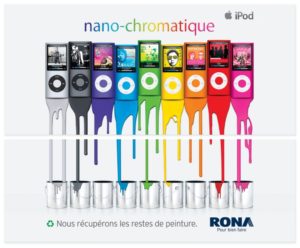
- Grassroots guerrilla marketing is when a business targets a small audience believing they’ll spread the message to larger groups. It’s relatively affordable to run grassroots marketing campaigns because they focus on a few people.
The Dove Real Beauty campaign is a good example of an inspiring and memorable grassroots marketing campaign.
- Stealth marketing is when you promote your products or services so your audience won’t even notice. Popular examples of stealth marketing are free taste samples or product placements on television shows and movies. This marketing method is mostly used to stir audience interest rather than generating immediate sales.
Is guerrilla marketing right for your small business? Consider these situations to know if you should use guerrilla marketing:
- If you want to grab attention quickly
- If you have a limited budget
- If you want to create a stir
Guerrilla Marketing Examples to Inspire Your Brand
Sidewalk Chalk:
Perhaps the all-time best (i.e., simplest, safest, and cheapest) guerilla marketing campaign is the old standby: sidewalk chalk. If done right, it can be very catchy, and could even gain the attention of social media.
Like Vapiano did below, you can use stencil and chalk rubbings to make a very professional-looking ad that leaps right off the sidewalk.
Note: Make sure to go through the legal channels to obtain consent of the owner – in this case local or state government bodies.

Kitkat Philippines
Idea
KitKat Breaker Benches, a reinvented approach to a classic brand asset, allows consumers to experience a different kind of KitKat break. Whatever kind of break you decide to take, there’s a KitKat bench made for it.

Check out more information about Kitkat’s campaign
Samsung’s latest promotion is flipping creative.
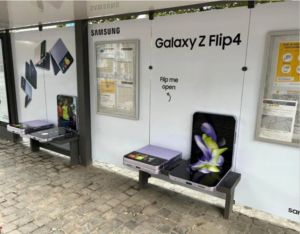
Regular benches in this bus shelter (spotted in Belgium) have been switched out with seats styled as XL Galaxy Z Flip 4 phones which customers are encouraged to ‘flip open’.
Conclusion
Guerrilla marketing can be a great way to reach a wider audience with your message, but it’s important to plan your campaign carefully to make sure you get the most for your money.
- Plan your campaign carefully
- Choose the right mediums for your message
- Make sure your campaign is timely and relevant
- Keep your costs down without sacrificing quality
Guerrilla marketing can be a great way to spread the word about your business, but it’s important to remember that it’s not a magic bullet. Make sure you plan your campaign carefully. If you do, you’ll be well on your way to a successful guerrilla marketing campaign.
-
6 of the Best Movies to Get You Inspired to Work!
Leave a CommentThe year is coming to an end, and what better time than to start planning our new year’s goals and strategies, but first, let’s fuel our souls with these 6 inspiring career-related movies
These movies are not only entertaining, but also helpful in improving your job skills and outlook on the world!
Stir away the Monday blues with these movies! Happy binge-watch weekend!

1. The Devil Wears Prada (2006)
One of the best movies ever, starring the legendary Meryl Streep, Anne Hathaway, and Emily Blunt and it will remind you that as long as you love your job you can handle all the pressure. Just remember to not lose yourself for your dream job.
The Plot: In New York, the simple and naive just-graduated in journalism Andrea Sachs is hired to work as the second assistant of the powerful and sophisticated Miranda Priestly, the ruthless and merciless executive of the Runway fashion magazine.

2. The Social Network (2010)
Get back to the basics with the Social Network.
The plot: As Harvard student Mark Zuckerberg creates the social networking site that would become known as Facebook, he is sued by the twins who claimed he stole their idea, and by the co-founder who was later squeezed out of the business.

3. The wolf of wall street (2013)
The Wolf of Wall Street is based on the story of Jordan Belfort, who becomes a stockbroker and cheats his way to richness.
If we set aside the fact that he eventually loses everything and goes to prison, we can learn a lot about Belfort’s skills that enabled him to achieve success. These include his communication skills and his ability to motivate people.
From the American dream to corporate greed, Jordan Belfort goes from penny stocks and righteousness to IPOs and a life of corruption in the late 80s. And this movie tells the story beautifully. A dark comedy for the ages, it highlights the best and worst in people, teaching viewers some great tips for achieving success along the way.
Valuable lessons: Perseverance is crucial. Don’t forget to dress and act the part. Be careful about what you are sacrificing for the sake of money or success.
The Plot: Based on the true story of Jordan Belfort, from his rise to a wealthy stock-broker living the high life to his fall involving crime, corruption and the federal government.

4. The Internship (2013)
The internship is one of the funniest movies, starring Owen Wilson and Vince Vaughn. The movie can be your source of motivation to always keep going and never give up. Discovering and utilising what skills you have.
The Plot: Two salesmen whose careers have been torpedoed by the digital age find their way into a coveted internship at Google, where they must compete with a group of young, tech-savvy geniuses for a shot at employment.

5. The intern (2015)
A movie that gives you all the feels, no matter where you are in your journey or career. You’re never old to do something brand new. The movie stars Robert De Niro and Anne Hathaway.
The Plot: Seventy-year-old widower Ben Whittaker has discovered that retirement isn’t all it’s cracked up to be. Seizing an opportunity to get back in the game, he becomes a senior intern at an online fashion site, founded and run by Jules Ostin.

6. Steve Jobs (2015)
Based on Walter Isaacson’s groundbreaking book and directed by Academy Award winner Danny Boyle, Steve Jobs takes us behind the scenes of the digital revolution to paint a portrait of the man at its epicentre. Steve Jobs may have been one of the most revolutionary figures of the 20th century–creating both Apple and Pixar–yet his full story has never been told until now. Told primarily in three parts–the story of an awkward misfit who transforms into a cultural icon and then becomes a complicated yet inspiring father figure–Steve he chronicled a journey like no other in modern history.
Steve Jobs takes us behind the scenes of the digital revolution, to paint a portrait of the man at its epicentre. The story unfolds backstage at three iconic product launches, ending in 1998 with the unveiling of the iMac.
That’s the end of our list, we understand that it can be hard to get out of a rut. If you find yourself feeling less than enthused with your workday, see if any of these movies pique your interest. No matter what skills or journey you have gone through in your career so far, there will be a movie in this list that speaks to your current situation. What better way to rejuvenate than by taking some time this weekend to enjoy some quality entertainment?
-
Branding vs Marketing | 5 Ways to Know the Difference!
Leave a CommentAre you a new business owner? Marketing beginner? Or even a professional marketer? Stop here; you have reached the right place because today, we will answer the question that baffled you and many others.
The ultimate need to differentiate between branding and marketing stems from your desire to gather long and short-term sales. Here we will separate and dissect branding and marketing to help you create a robust, sustainable, and scalable business.
Even though marketing and branding are two different concepts that are an integral part of any business, they are frequently used interchangeably.
1. The definitions of marketing and branding
It’s important to understand that branding is the big umbrella that encompasses all your business, from communication to how you decorate your store or office. Branding is the impression your audience recalls long after seeing your marketing.
We use branding to raise awareness and elicit an emotional attachment to your product or service. However, marketing is one aspect of utilising your branding to promote a new product/service, increase sales, and achieve short-term goals.
2. Branding is Identity; Marketing is Promotional.
Branding is everything about your brand and the emotional connection you create with your target audience through everything you do.
A versatile branding is consistent, clear, concise communication of your brand’s stand. When we think of versatile, memorable branding, we immediately think of brands like Apple, Starbucks and Pepsi, to name a few.
If you examine why those brands stand out, you will mostly feel the distinction of each brand’s message, not just the logo or their latest marketing activity. You will think of Apple’s neat and minimalistic design. You’ll think of chicness and sophistication.
Resonate and build a strong fanbase by utilising your branding elements in every brand communication.
Example: Pepsi and Coca-Cola have almost the same taste, although we always find some people who are more connected to Coca-Cola than Pepsi and vice versa. This emotional attachment and loyalty are precisely the power of branding.
Check out the importance of creating a veristile branding.
What is Marketing?
Marketing is the encompassing activities a company undertakes to attract potential customers through promoting the buying or selling of a product or service, including advertising, selling, and delivering products to consumers or other businesses.
So, if marketing is how you build awareness, your branding will keep your customers returning for more.
Also, some companies outsource a professional agency to handle this type of work so ask for our marketing services or click on the link to know more about us, Feur Media House
3. Which Comes First; Branding or Marketing?
Let’s settle this argument. You definitely can’t market a brand you haven’t fully invented yet, which means branding always comes first.
Know what your brand personality should be like, what characteristics you wish to convey, and what it stands for. Why should others care about your brand and not competitors?
By creating the logo, your persona, and other branding structures, you can then start your marketing process with tactics and strategies that highlight your branding.
Experienced marketers follow the right strategy for both branding and marketing to convey their message and invite and retain loyal customers.
4. Branding is the Essence. Marketing is the Message
Branding is perception. It taps into your customer’s thoughts and feelings instead of simply telling them to buy your product.
The goal of a brand strategy is to resonate with the consumer so that they choose your products, services or businesses over the competitors.
Branding is the impression your audience recalls long after seeing your marketing.
A well-applied brand strategy affects all aspects of a business, as it’s all the stuff that feels intangible and directly connected to consumer needs, emotions, and competitive environments.
Find out the 6 factors of a successful advertisement plan.
Elements of a Brand Strategy
1.Purpose
2.Consistency
3.Emotion
4.Flexibility
5.Employee Involvement
6.Loyalty
7.Competitive Awareness
“If people believe they share values with a company, they will stay loyal to the brand” Howard Schultz .
What is the proper marketing strategy?
On the other hand, marketing is a more direct and explicit effort to influence people to buy a product through videos, ads and sponsored content.
There is no specific strategy we can apply for all products and services, but there are diverse strategies each can be used depending on campaign goals, targeted audience and budget.
There are two types of marketing strategies: traditional and digital marketing.
- Traditional Marketing: event marketing, outdoors, video production and print marketing.
- Digital Marketing: search engine marketing, social media marketing and E-mail marketing.
- Branding is a long-term commitment. Marketing is based on short-term goals.
The goal of any marketing activity is a part of its strategy; first of all, we can say that the absolute goal and benefit of marketing is to drive sales, and we can achieve this goal through several sub-goals refinable, appreciable and emotional.
Those goals should be all measurable, relevant and time-bound.
On the other hand, the branding goals are entirely different in that they are connected to the brand itself, raising audience awareness towards the brand, establishing a solid brand identity and acquiring customer loyalty, all the previous obtain sales in the long term.
Now you can distinguish between both marketing and branding. Also, you can get more professional assistance to grow your business by contacting us, Feur Media House, with +35 years of experience in digital marketing and media services.
-
6 Essential elements for a successful advertising plan!
Leave a CommentHow many advertising campaigns have you seen? How many of them do you think worked?
Have you ever thought about why some campaigns work while others don’t?
Here you can find the answers.
Advertising is a bundle of communication techniques created to persuade a specific audience or masses to take particular actions towards the product, service or idea you advertised.
Advertising is always connected with the present; daily updates and newly born channels, either online or offline.
So, to drive the whole process and get the required results, every step has to be well-planned
And here, the secret lies in the word “advertising plan “.
An advertising plan is a documented strategy that shows how the company intends to communicate with the audience to deliver the desired key message through determining the audience, key message essence and the medium between them.
A successful advertising plan mix should answer the following questions one by one.
1. How can you describe/analyse the company’s current situation?
Make a “list” of the company’s problems VS their open opportunities in the market.
An advertising message should address a problem and turn these problems into opportunities.
*Apple Problem Statement
Apple has experienced a decline in iPhone sales due to a lack of innovation, along with a higher price tag. After conducting research, it seems that Apple has become complacent with their product line and did not feel the need to completely change their latest iPhone.
So Apple needs to reevaluate their production process and include more quality checks. This will ensure the company’s vision is met with their latest product. By increasing their Research and Development, Apple will be able to redesign their iPhone and recover from their decline in sales.
2. How should you structure a framework for your company’s approach?
• Define specific advertising goals
• Get the revenue and market share statement for the required (product –service)
• Add another list that includes: Your company’s top competitors – their services/products – their marketing strategy – their advertising applications.
• Mention your company’s products/services accompanied by results of any marketing research you have conducted
“Amazing things will happen when you listen to the customer.”
Jonathan Mindenhall
To get a significant result, you need to set your audience profile (Demographics – interests – behaviour)
• Define your company’s competitive advantage
3.How should your advertisement look and feel?
After answering the previous questions now, you can set a guideline for the campaign creative that gathers all your recommendations for the visuals, content, tone, etc.
For example:
Color palette: primary and secondary colors
Typography: font styles, sizes, and spacing
Other imagery: photos, illustrations, and artwork
Voice and tone: how the campaign uses language and emotion
4.What is your promotional plan?
Top 3 elements you need to consider while setting your promotion plan.
• The most effective cost route.
• Duration and timing of your advertising (Yearly, seasonally, etc.)
• Determine the best promotional channels (Influencer marketing, Offline advertising, Online advertising, Partnership marketing.. ETC)
5.How should you set your budget?
Balance is the “Key” neither spending too much that causes a waste of resources nor spending too little, so you will not achieve your goals. Also, you must remember that new practices or services will require more advertising.
6. How can you measure the success of your advertising campaign?
Take it as advice but don’t EVER think about “tracking the campaign results” after you have started it.
Tracking the results methods are as essential as creating the campaign itself. Starting a campaign means that you have already determined your results tracking methods as “Website Analytics, Phone Tracking, CRM Tracking, Split Testing, KPI Tracking.”
That each method of them may need another article. But for this one, I think we are done now. Always remember, “Creativity without strategy is called art, creativity with strategy is called advertising”
Now, I want to let you sum up all the previously asked questions, rearrange your priorities and start to prepare for each, reclassify your resources to answer them. Specify your company’s situation, certain your framework and set your budget to get wonderful results.
In your opinion, what do you think is the most important step to building your advertising plan?
-
The Advantages of Hiring a Marketing Agency.
Leave a CommentMarketing is one of the ruling factors to support your business to stand out from the crowd and grab your customer’s attention.
Hiring a full-service marketing agency will introduce you to an experienced and dedicated team that can execute your vision and help you achieve your business goals.
Picking the right marketing agency for your company can streamline your conceptual business ideas into a personalised, actionable plan that will effectively reach your audience and maximise your return on investment (ROI).
The choices
Luckily, you can hire a marketing agency while keeping your in-house marketing department. This is still an option to make good use of the benefits of having both.
If you need to reduce costs effectively, then hiring a marketing agency for the job is quite sufficient.
Then. Tell me more about the benefits!
1. Cost-efficiency
Salaries for marketing professionals can be quite expensive. From 2016 to 2017, the average salary of a Director of Marketing increased by 17%, and the average salary of a Content Strategist increased by 40%! Read the full report here.
Not to mention the efforts of the interviewing, cv screening, offers’ negotiations and the time consumed in the long hiring processes.
2. Package of skillset
Hiring an agency gives you broad access to web designers, copywriters, data analysts, PPC advertisers, social media managers, content creators, SEO experts, and more.
You actually get all your marketing services consolidated for one fee while maintaining experience and follow-up.
3. Single Point of Contact
Having a single point of contact is a blessing. You only have one contact person in the marketing agency you refer to (usually the account manager and sometimes even the CEO himself).
This communication process keeps you focused and enables your organisation to assess the performance of your marketing activities through one person.
4. A fresh perspective, neutral approach!
An agency is an external eye on your business. It can look at your business objectively and report the pros and cons. You need impartial feedback rather than compliments!
Another advantage is that the marketing agency has broader access to the market and can help you assess the competitors’ performance and plan accordingly.
Additionally, agencies’ skills and tools help them create data-backed strategies for your business.
The excellent utilisation of this data is crucial to the success of your business. You would not be able to obtain this type of consolidated data quickly and easily if you depended on your in-house marketing department.
5. More focus on your business.
Most people forget that successful marketing results start from a clear business vision.
By hiring a marketing agency, you will pay them to do their job while you focus on your business goals and visions. You need your full potential and energy for this task while leaving the details, the execution, and the details for them to perfect.
Do you really have enough time to follow up on the day-to-day activities of all your social platforms or a marketing campaign’s effectiveness?
6. Securing the future!
The marketing world is changing rapidly. We are witnessing the digital revolution and heading to robotics very soon.
A marketing agency is more flexible about changes and is keen on keeping up with the fast-paced world of business!
Working with an advertising agency gives the advantage of being flexible and dynamic about the market’s minor and major changes.
This is also correct in entering more players and competitors into your business’s market. Securing the future is crucial to your business in the long run.
-
The power Of Social Media
Leave a CommentBillions of people worldwide use social media to search for knowledge and entertainment, connect with family and friends, and express themselves. This space is getting wider daily, dominating almost every aspect of our lives, relations, moods and businesses.
What is social media?
Social media is an internet-based form of communication. A social media platform is an online sphere that targets a certain group of people with similar mindsets, demographics and interests.
Each social media platform sets its own tone, user interface, usability and the business aspect through which it can generate revenue based on its business model.
Social media platforms include blogs, micro-blogs, wikis, social networking sites and applications, photo-sharing sites, instant messaging, video-sharing sites, podcasts, widgets, virtual worlds, cell phone apps, networking games, and more.
Power of the People!
It is “social” because people “socialise”! People control it.
People tend to “communicate”. Information runs between a “sender” and a “receiver” directly, instantly, one-to-many-and-back-again method.
No limit; information runs around freely and virally. Any topic can be discussed directly among constituents, regardless of their physical location.
This is unlike traditional media like TV, Radio and Newspapers that depend on one-way communication! The sender controls the process.
Thus, the power of the people changes the game. Social Media dominates!
Power of social media for business
Businesses are based on people, and it is targeting! Where people are found, money is there!
It is about what, how and when to start grabbing it. According to sproutsocial, 55% of consumers know about a new brand/product on social media.
It is now about being globally recognised.
Traditional marketing communication methods are declining in favour of social media!
Organic or paid?
One of the many benefits of marketing of social media marketing is that it can be totally free. Make sure your content and material are relevant and valuable; thus, your product/service can go viral organically without paying a penny to any social media platform!
On the contrary, paid campaigns are targeted at a specific target audience, and there is an allocated budget for it in the business marketing plan.
It is crucial to differentiate between these terms while social media marketing is mentioned.
What are the top five benefits of Social Media marketing?
1. You are getting noticed via SEO!
Most social media platforms send signals and data to search engines via SEO (Search Engine Optimisation). Briefly, it is the ranking of a website whenever someone searches for something using a search engine. The order of web links that are seen first! Many factors contribute to higher search engine ranking, and social media is a major one!
FEUR Media House offers SEO Services to help you get a higher ranking for your website.
2. Improving Brand Loyalty
Social media networks allow for direct and (almost) real-time two-way communication. Brands should take advantage by being available to respond to their questions, inquiries, comments, and complaints.
Over time, you build a rapport with your followers, gain their trust, turn them into customers, and eventually make them loyal to your service/brand/product/page.
Loyal followers will act as brand advocates later on, and their engagement will be crucial to your online image and will be reflected on SEO ranking.
In today’s highly competitive market, the customers have more and more choices. Brand loyalty is becoming more critical than ever.
Using the power of social media properly will be a huge advantage in improving it.
3. Boost your brand awareness
You can increase your brand recognition by using the right tools and the proper content material.
While pursuing presence and recognition online, try to focus on a few social media platforms to be easier to maintain. Pick quality over quantity. Each platform has a different demographic that you need to link to your
Try to follow a social media strategy, stick to it, and ensure it is relevant to your overall marketing plan.
Make sure to refine your page bios, polish your cover photo and update your contact information.
FEUR Media House helps you create effective awareness campaigns and plan a social media strategy to spread your brand awareness among your targeted audience and potential customers.
4. Crowdsourced and User-Generated Content (UGC)
Your customers can participate in creating your content. Another important advantage of social media is that you rally your customers to work for you as a team of marketers!
You can encourage your fans and followers to deliver user-generated content on social media.
Ask them to post photos or videos along with your branded hashtag or write down their impression about your new promotion, packaging, specific product, etc.
You can even ask them to participate in your future marketing plans by sharing their thoughts. At the same time, you collect these data immediately and directly with a clear direction of their demographics.
Next, your social media team can track the hashtags, collect the content they post and reply to them. This creates an engagement with your followers and encourages them to come back and revisit your page.
That way, you are not receiving the content, but others post it on social networks. It is being seen by each of your fan’s networks individually as well as your brand and your network.
People trust people more than brands; UGC is content created by people.
Our team of professional social media specialists at FEUR Media House can help you set your UGC goals and share the secrets of the trade to tempt your customers and followers to engage with your social media platforms.
5. Measuring Success with Analytics
You cannot manage what you cannot measure!
Remember how difficult it was to measure your marketing efforts in the past, marketing research firms, focus groups, paper-based surveys, street interviews, etc.
Social media revolutionised the way marketing data is collected. Every single detail you need to know about your customers, consumer behaviours, trends and feedback is digitalised.
There are hundreds of social media tools through which you can receive a comprehensive report that you can use as a trustworthy source for your business.
You get full insight into each social media platform’s performance and learn more about which of your social media posts and content is performing best with which audience.
It also provides you with in-depth recommendations of what you need to do in the future, which is a great asset for your decision-making process about which platform you need to invest in more and those that need to be abandoned.
The power of social media for business in figures
According to sproutsocial, there are seven important figures that proved the importance of social media for business.
1. 55% of consumers learn about new brands on social media.
2. 68% of consumers agree that social media enables them to interact with brands and companies.
3. 43% of consumers increased their social media use to discover new products in the last year.
4. 78% of consumers are willing to buy from a company after having a positive experience with them on social media.
5. 80% of business executives think investing additional resources in social media marketing is essential.
6. 91% of executives will increase social media marketing budgets in the next 3 years.
7. 72% of companies use social media data to make business decisions.
Read the full survey results here.
